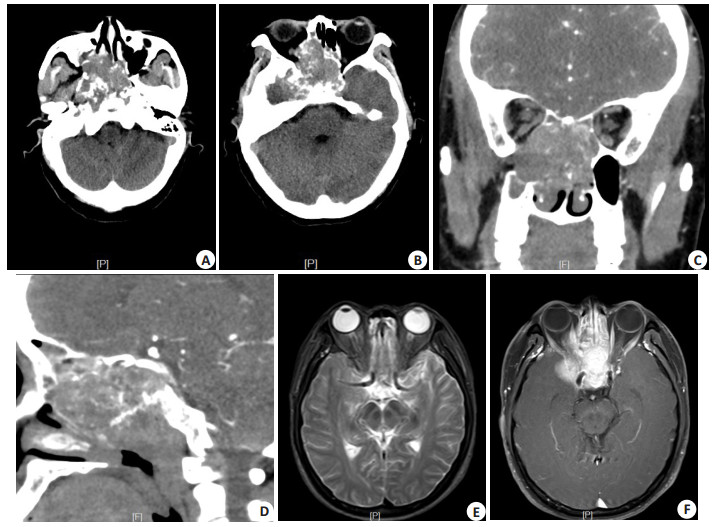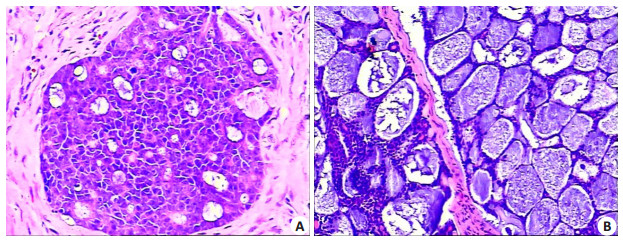腺样囊性癌(ACC)是具有一定临床生物学特点的低度恶性肿瘤,多发于口腔涎腺组织,其中以腮腺最多[1],而发生于鼻腔鼻窦者较少。但从鼻腔鼻窦恶性肿瘤的病理类型来说,ACC是仅次于鳞癌的病理类型[2]。ACC生长较缓慢,常因症状隐匿难以早期发现,故就诊时多处于晚期。国内外关于本疾病的报道,多将早中晚各期病例集中研究,而对于晚期ACC的临床特征,尤其是发生于鼻腔鼻窦的晚期患者的临床诊疗特征尚未见有文献进行系统报道。由于病理类型、临床分期和治疗方法等不同因素的差异可直接影响其预后[3],本文回顾总结了2007年2月~2016年5月入住我院的21例晚期鼻腔鼻窦ACC患者的诊疗特征,并结合相关文献进行分析,探讨其临床特征、治疗方法、预后及影响因素,以期促进个体化治疗方案制定,提高患者生存率。
1 资料和方法 1.1 临床资料21例患者均为我院2007年2月~2016年5月收治并经组织病理学确诊的鼻腔鼻窦ACC,排除发生于腮腺、上颚、上颌骨及身体其他部位的患者。男13例,女8例;年龄23~69岁,平均年龄47.43岁,中位年龄44岁;病程1月~10年,平均病程15.19个月,中位病程7月。主要临床表现:鼻塞12例、鼻出血6例、脓涕9例、面颊肿胀2例、头痛4例、眶区肿胀2例、视力下降4例。鼻内镜检查2例在鼻腔发现粘膜下肿块,其中1例见右鼻腔外侧壁隆起,并向鼻中隔挤压,1例在鼻中隔后端隆起,第2次复发, 蝶窦发现肿块。
鼻内镜检查:鼻腔鼻窦见可疑新生物隆起,表面光滑(图 1)。影像学检查:21例患者CT或MR示鼻窦为主的鼻腔鼻窦肿块影,增强扫描中度强化,肿物向周围侵犯,多破坏周围窦壁骨质、累及周围正常软组织结构,包括向前突入鼻腔,向外侵及眶内,向上累及垂体、视交叉、海绵窦,向后外累及翼腭窝,向下侵犯鼻咽部等(图 2)。4例出现颈部淋巴结肿大,1例远处转移。病理检查:21例患者病理全部确诊为ACC。病理特征为瘤细胞小,胞浆少,核大,深染,呈实性巢状、筛状和腺管状排列,浸润性生长(图 3)。临床分期:按照AJCC癌症分期手册(第6版)[4]鼻腔和鼻窦肿瘤分期标准,将所有病例进行分期,21例中T3N0M0 6例,T3N2M0 6例,T4N0M0 7例,T4N2M0 1例,T4N2M1 1例。其中肿瘤来源于上颌窦者13例,源于蝶窦7例,源于鼻腔1例。随访:所有病例随访日期自初治之日起(放疗、手术或化疗)至2016年8月,随访时间3~114月,平均随访56.4月,中位随访时间58月。随访方法为电话及患者门诊复查记录。

|
图 1 1例晚期鼻腔鼻窦ACC的鼻内镜图像 Figure 1 A female patient with ACC in the nasal cavity and paranasal sinuses detected by nasal endoscopy 3 days prior to admission. A: Submucosal tumor in the left nasopharyngeal region; B: Submucosal tumor in the right rhinal fissure; C: Submucosal tumor in the right middle nasal meatus; D: The right nasopharyngeal tumor. |

|
图 2 晚期鼻腔鼻窦ACC的CT及MR图像 Figure 2 CT and MRI images of a female patient with ACC in the nasal cavity and paranasal sinuses. A: Maxillary sinus invasion; B: Orbital and optic nerve invasion; C: Orbital apex invasion; D: Clivus invasion; E: Cavernous sinus invasion; F: Temporal lobe invasion. |

|
图 3 晚期鼻腔鼻窦ACC的病理图片 Figure 3 Pathological pictures of ACC in the nasal cavity and paranasal sinuses (HE staining, original magnification: ×100). A: The mixed tumor involving over 30% solid cell nest; B: Most of tumor cells show tubular and cribriform alignment. |
手术治疗16例。手术方式:鼻侧切开筛窦及鼻腔肿瘤切除术4例,柯陆氏进路上颌窦根治术9例,鼻内镜下鼻腔肿瘤切除3例,其中术后放化疗9例,术后放疗3例,单纯手术4例。手术及其术后结合放化疗者存活8例,死亡8例,存活率50.0%。5例不能手术或拒绝手术的患者采用根治性放疗+化疗,存活2例,死亡3例,存活率40.0%。辅助化疗:采用顺铂+5-FU诱导化疗或单用顺铂或5-FU同步增敏化疗。
1.3 统计学处理通过SPSS软件采用Kaplan-Meier法和Log-rank检验对年龄、性别、病程、病理分型、发病部位、分期及治疗方法进行单因素生存分析,采用COX模型对影响预后的临床因素进行多因素分析,P < 0.05为差异有统计学意义。
2 结果分别对年龄、性别、病程、病理分型、发病部位、分期及治疗方法进行Kaplan-Meier单因素分析(表 1)。21例患者中,实体型占比小于30%的10例(47.6%),1、3、5年总生存率分别为100%、100%、71%,实体型占比大于等于30%的11例(52.4%),1、3、5年总生存率分别为70%、40%、10%,两者差异有统计学意义(P=0.02),且实体型占比大于等于30%患者预后较差。Log-rank检验及全变量模型下协变量的生存曲线表明病理分型对预后具有显著影响,预后T3期略优于T4,上颌窦略优于蝶窦,手术及放化疗综合治疗优于单纯手术及单纯放化疗。多因素Cox回归模型分析结果显示,病理分型、病程与预后关系密切(P=0.045、0.028,表 2)。
| 表 1 21例ACC患者单因素生存分析 Table 1 Univariate survival analysis in 21 patients with ACC (Mean±SD) |
| 表 2 21例ACC患者的多因素生存分析 Table 2 Multivariate survival analysis in 21 patients with ACC |
鼻腔鼻窦ACC发病率较低,仅占所有鼻腔鼻窦恶性肿瘤的10%,占头颈部腺样囊性癌的10%~25%[2]。该病男女性发病率文献报道不一,Spiro等[5]认为男性的发病率更高,而其他文献报道中发病与性别无关[2, 6]。多数研究认为60岁左右是鼻腔鼻窦ACC高发期,但实际发病年龄跨度可从小于20~80岁以上[5]。本研究病例多为50岁以上(57.1%),中位年龄44岁(23~69岁),单因素及多因素生存分析结果显示性别及年龄不影响患者的生存情况。
发生于鼻腔鼻窦的ACC早期症状不易察觉,就诊时多为晚期,晚期患者易引起周围多器官病损如侵犯颅内、眼眶、颈内动脉、上颌神经、下颌神经及翼管神经、颞下窝及翼腭窝等[7]。ACC有嗜神经特性常沿神经分布生长,易局部复发与远处转移,但很少发生淋巴结转移[8]。上颌窦是ACC最常见的发病部位,其次为鼻腔、上颚、筛窦及蝶窦,且位于鼻腔者存活率最高,位于蝶窦者存活率最差[2, 9]。本研究有13例(61.9%)发生于上颌窦, 7例(33.3%)源于蝶窦,1例(4.8%)源于鼻腔,且就诊时发现肿瘤均已累及周围骨性及软组织结构,按鼻腔鼻窦恶性肿瘤TNM分期均为晚期患者。通过Log-rank检验进行生存率比较,结果显示上颌窦略优于蝶窦。
鼻腔鼻窦ACC在临床症状方面与发生在鼻腔鼻窦其他恶性肿瘤的表现基本无特异性区别,只是因为本病为低度恶性,有些病例在病程上稍长,本研究有病例病程为10年,因此临床上出现较长病程但影像学又怀疑为恶性肿瘤者应该考虑本病。一般来说,该肿瘤生长缓慢,带瘤生存时间较长,多数患者可获得长期生存[10]。在影像学方面与该部位其他恶性肿瘤比较后发现,ACC以不规则的软组织肿块为主要征象;易沿神经生长,表现为通过三叉神经三条分支经翼腭窝、圆孔及卵圆孔侵犯鼻腔鼻窦外组织及颅内;易破坏周围骨质;CT平扫密度不均,增强以中度或显著强化为主;MRI显示肿瘤信号不均匀为特点[11]。本研究21例行CT检查,均显示不规则的软组织肿块。沿神经生长,破坏周围骨质。12例行MRI,显示呈长T1、长T2信号,增强扫描不均匀强化,可见混杂信号影。
晚期鼻腔鼻窦ACC因临床表现复杂,无典型临床症状和特异性影像学特征,与其他一些良恶性病变难以鉴别,易造成误诊。本研究中15例病理确诊ACC的患者均有不同程度的误诊,分别被误诊为后鼻孔息肉、上颌窦粘膜囊肿、慢性鼻-鼻窦炎、鼻中隔后端偏曲、三叉神经痛、眼科炎症性疾病。故临床工作中对进行性鼻塞、鼻出血、眼球突出、面部肿胀、颚部肿物症状,应考虑有ACC的可能,尽早活检,降低误诊。
晚期鼻腔鼻窦ACC确诊有赖病理学检查。ACC从病理学上分筛状型、腺管型和实体型[12]。以筛状型最常见,肿瘤细胞排列呈筛网状,筛网内含黏液样物或透明样物;腺管型可见两层细胞组成的管状结构,内层为上皮细胞,外层为肌上皮细胞实质性最不常见。实体型显示肿瘤细胞成层状分布,只有少量腺管或筛孔可见[13]。三型细胞密度依次增加,预后逐步变差[14]。但ACC常以混合型存在。大部分为腺管型和筛状型组成的混合性预后好,超过30%实体型组成的混合性预后差[15]。本研究中实体型占比小于30%与大于等于30%相比,二者在例数及1、3、5年总生存率的差异均有统计学意义,从而证实了实体型占比大于等于30%预后差。
晚期鼻腔鼻窦ACC治疗原则应以手术及术后辅助放化疗的综合治疗为主[16-17]。Lupinetti等[2]研究了105例鼻腔鼻窦ACC患者,认为手术及术后辅助放疗比单独手术及单独放疗者总体生存率明显提升。Frcs等[18]报道同步放化疗对ACC患者是一种可行的治疗方案,但局限性是病例数过少(n=16)。一项88例鼻腔鼻窦ACC临床分析指出在鼻腔鼻窦ACC患者中治疗方式与生存率相关,综合治疗优于单纯治疗,手术加放疗优于单纯放疗或单纯手术治疗,两两比较差异有统计学意义[10]。本研究病例全部为晚期患者,Log-rank检验及生存率比较结果显示,手术及放化疗综合治疗优于单纯手术及单纯放化疗。因此手术及放化疗综合治疗更应成为鼻腔鼻窦晚期ACC患者的首选方式。且本研究早期病例手术以鼻外进路为主,近期病例采用鼻内镜下手术,鼻内镜下手术对患者创伤小,安全性提高,恢复快,能更好更快的衔接后续的化疗及放疗过程[19]。
晚期鼻腔鼻窦ACC的预后比较差,预后的影响因素有很多。Garden等[20]通过头颈部198例ACC患者临床情况的多因素分析指出:重要神经侵袭及手术切缘阳性增加了手术加术后辅助放疗方案的失败率,远处转移是治疗失败的最常见原因。手术加术后辅助放疗能很好地控制肿瘤复发,并推荐肿瘤床放疗剂量在60 Gy,手术切缘阳性者增至66 Gy。Amit等[9]也提出手术切缘阳性和肿瘤发生部位是影响患者生存率的主要因素。本组5例死亡患者中远处转移4例(80%),局部复发1例,局部复发者放疗剂量52 Gy,其余放疗剂量均大于60 Gy。说明远处转移是患者死亡的主要原因,其次为局部复发,术后放疗剂量不足60 Gy是影响患者预后的因素[21]。另一项129例的ACC的患者临床研究中发现,在晚期实质型、未分化型,P53蛋白的表达是独立的重要预后影响因素[22]。尽管预后的影响因素多样,但多数研究认同T4期、周围神经侵袭、手术切缘阳性及术后放疗剂量不足60 Gy是影响预后的主要因素[23-24]。
综上所述,病理分型、病程、发病部位、分期、治疗方式、周围神经侵袭、手术切缘阳性及术后放疗剂量不足60 Gy可能是影响晚期ACC患者预后的因素。本研究发现鼻内镜微创手术及放化疗综合治疗更应成为鼻腔鼻窦晚期ACC患者的首选方式,可提高患者生存率,改善预后。
| [1] | Binesh F, Akhavan A, Masumi O, et al. Clinicopathological review and survival characteristics of adenoid cystic carcinoma[J]. Ind J Otolaryng Head Neck Surg, 2015, 67(1): 62-6. |
| [2] | Lupinetti AD, Roberts DB, Williams MD, et al. Sinonasal adenoid cystic carcinoma -The M.D. Anderson cancer center experience[J]. Cancer, 2007, 110(12): 2726-31. DOI: 10.1002/cncr.v110:12. |
| [3] | 陈琦. 影响腺样囊性癌预后的多因素回归分析[J]. 国际口腔医学杂志, 2015, 42(5): 531-4. DOI: 10.7518/gjkq.2015.05.010. |
| [4] | Greene FL, Page DL, Fleming ID, et al. AJCC cancer staging handbook[M]. New York: Springer-Verlag, 2002: 73-80. |
| [5] | Spiro RH, Huvos AG, Strong EW. Adenoid cystic carcinoma of salivary origin[J]. Am J Surg, 1974, 128(8): 512-20. |
| [6] | Michel J, Fakhry N, Santini L. Sinonasal adenoid cystic carcinomas: clinical outcomes and predictive factors[J]. Intern J Oral Maxillof Surg, 2013, 42(2): 153-7. DOI: 10.1016/j.ijom.2012.11.007. |
| [7] | Chae YK, Chung SY, Davis AA, et al. Adenoid cystic carcinoma: current therapy and potential therapeutic advances based on genomic profling[J]. Oncotarget, 2015, 6(1): 37117-34. |
| [8] | 魏明辉, 唐平章, 徐震纲, 等. 鼻腔鼻窦腺样囊性癌40例临床分析[J]. 中华耳鼻咽喉头颈外科杂志, 2009, 44(5): 381-4. |
| [9] | Amit M, Binenbaum Y, Sharma K, et al. Adenoid cystic carcinoma of the nasal cavity and paranasal sinuses:a Meta-Analysis[J]. J Neurolog Surg, 2013, 74(9): 118-25. |
| [10] | 张芹, 杨蕾, 杨安奎, 等. 鼻腔鼻窦腺样囊性癌88例临床分析[J]. 中华耳鼻咽喉头颈外科杂志, 2009, 44(4): 311-4. |
| [11] | 陈瑞楠, 郑汉朋, 许崇永, 等. 鼻腔鼻窦腺样囊性癌CT和MRI诊断[J]. 医学影像学杂志, 2016, 26(2): 214-7. |
| [12] | Retting EM, Tan M, Ling SZ, et al. MYB rearrangement and clinicopathologic characteristics in head and neck adenoid cystic carcinoma[J]. Laryngoscope, 2015, 125(9): 292-9. DOI: 10.1002/lary.25356. |
| [13] | Bobati SS, Patil BV, Dombale VD. Histopathological study of salivary gland tumors[J]. J Oral Maxillofac Path, 2017, 21(1): 46-50. DOI: 10.4103/0973-029X.203762. |
| [14] | van Weert S, Reinhard R, Bloemena E, et al. Differences in patterns of survival in metastatic adenoid cystic carcinoma of the head and neck[J]. J Sci Specialt Head Neck, 2017, 39(3): 456-63. DOI: 10.1002/hed.v39.3. |
| [15] | 顾雅佳, 吴斌, 杨文涛, 等. 头颈部腺样囊性癌的磁共振成像表现与病理对照[J]. 中国医学计算机成像杂志, 2008, 14(2): 100-5. |
| [16] | Michel G, Joubert M, Delemazure AS, et al. Adenoid cystic carcinoma of the paranasal sinuses:Retrospective series and review of the literature[J]. Europ Ann Otorhinolaryng Head Neck Diseas, 2013, 130(9): 257-62. |
| [17] | Huang MW, Zheng L, Liu SM, et al. 125Ⅰ brachytherapy alone for recurrent or locally advanced adenoid cystic carcinoma of the oral and maxillofacial region[J]. Strahlenther Onkolog, 2013, 189(4): 502-7. |
| [18] | Frcs S, Brekel M, Kies MS, et al. Concurrent chemoradiation for adenoid cystic carcinoma of the head and neck[J]. Head&Neck, 2012, 34(4): 1263-8. |
| [19] | Wardas P, Tymowski M, Piotrowska SA, et al. Endoscopic approach to the resection of adenoid cystic carcinoma of paranasal sinuses and nasal cavity:case report and own experience[J]. Eur J Med Res, 2015, 20(7): 97-102. |
| [20] | Garden AS, Weber RS, Morrison WH, et al. The influence of positive margins and nerve invasion in adenoid cystic carcinoma of the head and neck treated with surgery and radiation[J]. Intern J Radiat Oncol Biol Physics, 1995, 32(3): 619-26. DOI: 10.1016/0360-3016(95)00122-F. |
| [21] | Jensen AD, Poulakis M, Vanoni V, et al. Carbon ion therapy(C12) for high-grade malignant salivary gland tumors(MSGTs)of the head and neck:do non-ACCs profit from dose escalation[J]. Radiat Oncol, 2016, 11(4): 90-8. |
| [22] | da Cruz PD, de Abreu AF, Nobuko NI, et al. Prognostic factors in head and neck adenoid cystic carcinoma[J]. Oral oncology, 2006, 42(2): 139-46. DOI: 10.1016/j.oraloncology.2005.06.024. |
| [23] | Chen AM, Bucci MK, Weinberg V, et al. Adenoid cystic carcinoma of the head and neck treated by surgery with or without postoperative radiation therapy:prognostic features of recurrence[J]. Intern J Radiat Oncol Biol Physics, 2006, 66(1): 152-9. DOI: 10.1016/j.ijrobp.2006.04.014. |
| [24] | 何倩, 韩亚骞, 刘峰, 等. 头颈部腺样囊性癌患者的预后及其影响因素分析[J]. 肿瘤药学, 2016, 6(4): 275-80. |
 2017, Vol. 37
2017, Vol. 37

